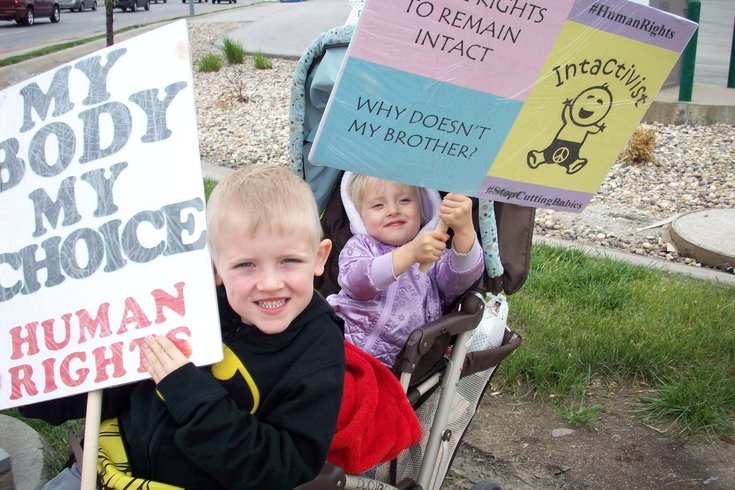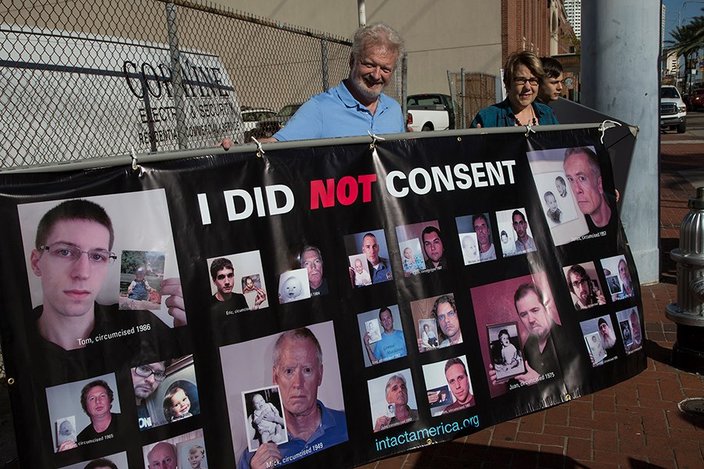
September 26, 2015
 Bloodstained Men & Their Friends/for PhillyVoice
Bloodstained Men & Their Friends/for PhillyVoice
Kelly Coventry at the Omaha Circumcision Crisis Protest with Bloodstained Men & Their Friends, Omaha, Nebraska
Rita’s daughter cries, again.
“I can’t take it!” Rita tells her mother on the phone. “For the past 24 hours, she has cried nonstop.”
“It will get better, Rita,” her mother replies. “You did the right thing.”
An hour passes. Then, it is time for a diaper change. Rita lovingly picks up her infant daughter and places her on the changing table. The little one cries.
“Shhh now…” Rita coos. “It’s going to be alright. You just have a wet diaper.”
Placing a comforting hand on her daughter’s small chest, Rita peels back the sticky tabs and opens the diaper only to recoil in shock. Blood, rather than urine, soaks the absorbent pad. Bright, red blood.
Sick to her stomach with hands shaking, Rita carefully opens up her daughter’s labia majora to look inside the girl’s genitals. Yes, the wound from yesterday’s circumcision is bleeding, a lot. No wonder she has been crying.
A trip to the hospital ensues. Rita’s husband Nate meets his wife and daughter at the ER. The infant is stabilized. Gratefully, there is no need for a blood transfusion. The stunned parents are instructed in wound care and comfort measures.
“Look, it’s terrifying,” the doctor on call affirms. “It is. But it’s rare. Only 1 to 2 percent of circumcised girls suffer complications and the benefits of removing the clitoral hood are well documented. She will be cleaner and protected from the possibility of cancers that infect the vulva.”
Rita nods affirmatively. She knows the facts. She herself is circumcised, as are her friends, sisters, aunts, and mother.
On the drive home, Nate breaks his unusual silence. “Maybe we didn’t do the right thing.” His voice shakes. “You know in Europe, they don’t circumcise girls.”
A traumatized, medicated, and exhausted infant sleeps in her car seat. Her parents drive home in silence.
“Cut a girl, go to jail. Cut a boy, cash a check.”
The story of Rita and Nate is fictional in just one sense. The couple authorized the illegal genital cutting of a daughter, not a son. In every other aspect, the dynamics of their story unfold daily for infant boys in the United States.
We stand alone as the only country in the world that routinely cuts the genitals of infant boys for non-religious reasons. This practice has spawned a multimillion-dollar industry centered upon the harvesting of foreskins (just “google” neonatal human dermal fibroblast). Doctors willing to profit justify the imposition of an elective, irreversible, painful, and risky procedure on the most private parts of infant boys who are unable to offer any semblance of consent.
If we had inherited the religious or cultural practices that celebrate the removal of a girl’s labia and/or clitoris, then the cutting of girls, the selling of their genital tissue, and an accompanying compendium of pseudo-scientific justification would be commonplace.
But we don’t cut our girls. It’s illegal.
To argue American parents can choose to subject their sons -- but not their daughters -- to an elective, cosmetic genital surgery is to fall into the trap of doublethink.
Even if American parents of girls hail from a culture where female circumcision is powerfully affirmed -- even if they embrace the least invasive form of female cutting and advocate its performance by medical professionals in a sterile environment -- the cutting of their daughters is illegal.
In fact, parents can be arrested for taking girls abroad for the procedure. An American girl’s genitals are legally protected, everywhere. It’s a felony to cut them.
Contrast this with the fact that one isn't legally required to have specified medical training, let alone a medical license, in order to circumcise a boy in America. Nor does the surgery need to be done in a clinical setting. According to John V. Geisheker, director and general counsel for Doctors Opposing Circumcision, the practice of cutting boys is “completely unregulated.” Geisheker writes, “Obstetricians with no training in male urology may proceed unimpeded, an irony that even they, who specialize in female anatomy, have noted." Furthermore, fringe practices surrounding male cutting, such as the oral sucking of the cut penis remain legal and openly practiced despite the fact that infant boys have contracted herpes, suffered brain damage, and died from such procedures.
Yes, we powerfully affirm the right to genital integrity for American girls. It is an ugly and blatant double standard to not extend analogous legal protections to our sons.
But isn't this like comparing apples to oranges? Isn’t female genital cutting a world apart from the cutting of a boy? There are no benefits to cutting a girl but there are numerous benefits to removing male foreskin, right? And what about parental choice or freedom of religious expression? Shouldn’t that, for parents of boys, take precedence?
A clear examination of these questions is in order.
The vast majority of men worldwide, between 70 to 80 percent, are intact. In many countries, infant male circumcision is virtually unknown. In the US, it is estimated that around 55 percent of infant boys are circumcised. Yet, the practice is becoming less popular each year. In some states -- like Nevada -- less than 10 percent of boys are cut. Even in conservative Utah, the practice declines. In an interview with City Weekly, a Salt Lake City publication, head of the Utah chapter of NOCIRC (The National Organization of Circumcision Information Resource Centers) Steve Scott notes throughout U.S. medical history a multitude of diseases have been erroneously linked to the presence of foreskin. Circumcision is “an industry in constant search of a reason to exist,” states Scott.
But it shouldn’t exist.
No medical organization in the world recommends infant male circumcision as mandatory or routine. Just this month, the Canadian Paediatric Society (CPS) reaffirmed its position “recommending against the routine circumcision of newborn males,” because its medically necessity “has not been clearly established.” The CPS noted that 111 to 125 infant boys would need to be circumcised to prevent a single case of urinary tract infection.
Key legal and ethical concerns centering upon the issue of consent were also highlighted. The CPS acknowledges that parents have the authority to make medical decisions on behalf of their children’s best interests. Yet this authority isn’t absolute. It is: “limited only to interventions deemed to be medically necessary. In cases in which medical necessity is not established or a proposed treatment is based on personal preference, interventions should be deferred until the individual concerned is able to make their own choices.”
Those in favor of supporting a parent’s religious or personal preference with regard to circumcising boys reveal a bias when they harshly condemn an analogous practice of cutting girls. To argue American parents can choose to subject their sons -- but not their daughters -- to an elective, cosmetic genital surgery is to fall into the trap of doublethink. Is a girl’s vulva more sacrosanct than a boy’s penis? Are the religious traditions that justify female cutting less holy than those that uphold the cutting of boys as sacred?
American parents who affirm an individual’s right to consent to elective genital surgery must do more than opt out of the procedural cutting of their sons. The time has come to advocate for the application of legal, long-lasting safeguards that unequivocally affirm the right of both boys and girls to physical integrity and autonomy.
I am well aware that this is a controversial and unpopular stand.
No doubt the idea that a boy’s right to genital integrity outweighs the interests of his pro-circumcision parents will infuriate a good portion of the American public. For Muslims and Jews who practice circumcision (a small minority do not), it may feel like a prejudicial assault on their faith. But it doesn’t need to.
If we can step back and calmly, compassionately, and mindfully reflect upon the questions posed above, we can begin to see clearly in our foreskin-phobic culture. We can begin to unravel the doublethink and sexist bias that protect only one half of American children from genital harm.
"The official viewpoint of KNMG (The Royal Dutch Medical Association) and other related medical/scientific organisations is that non-therapeutic circumcision of male minors is a violation of children’s rights to autonomy and physical integrity. Contrary to popular belief, circumcision can cause complications – bleeding, infection, urethral stricture and panic attacks are particularly common. KNMG is therefore urging a strong policy of deterrence. KNMG is calling upon doctors to actively and insistently inform parents who are considering the procedure of the absence of medical benefits and the danger of complications."
The official policy of the Royal Dutch Medical Association
“Female Genital Mutilation (FGM) and male circumcision: Should there be a separate ethical discourse?” by Brian D. Earp, Research Fellow in Ethics at the University of Oxford, makes for a worthy and compelling read.
Earp begins by noting there are several misleading and patently false beliefs commonly touted by those who condemn female cutting but embrace the cutting of boys.
Consider these sentiments:
FGM is complete mutilation, akin to castrating a male. Circumcising a boy is “just a snip,” rather painless.
The motivation to cut girls is sexist and solely related to diminishing or removing their sexual drive. Circumcising boys has many health benefits and has no impact on sexual function.
Untrained individuals, in unhygienic settings, mutilate girls. But doctors in sterile environments circumcise boys.
We live in a country that, since the early 20th century, has embraced male circumcision due to its purported health benefits. Combine this with the fact that we often deem the primarily African countries where female cutting is practiced as “other” and it’s easy to understand why Americans are quick to compare the most sexist, extreme, dangerous, and unsanitary forms of female cutting with the most sterile, medically sanctioned, and routinely accepted hospital-based forms of circumcising boys.
However, even a cursory examination of the origins of male circumcision in the US reveal that a powerful anti-masturbation agenda drove the practice of cutting boys into the arms of America’s medical establishment -- an establishment that successfully promoted the practice and claimed it curative for a wide range of illnesses such as frequent headaches or insanity.
The 19th-century Victorian reformer John Harvey Kellogg wrote extensive tracts opposing both male and female masturbation – something he decried as “self abuse.” Kellogg viewed circumcision “a remedy” which is “always successful in small boys.” He strongly suggested the operation “be performed by a surgeon without administering an anesthetic.” Why? The pain would have a “salutary” effect on the mind of the boy “especially if it be connected with the idea of punishment.” For girls, he advocated applying “pure carbonic acid to the clitoris” to hem in “abnormal excitement.”
American women can be grateful Kellogg’s vision of a masturbation-free female populace never took hold. We are free to experience sexuality with genitals intact. A growing number, controversially, may choose to alter them in search of the “designer vagina” (content advisory: link contains nudity) but the vast majority can be grateful that sexual capacity wasn’t limited by surgeries forced upon us as girls. (Though the practice of illegally cutting girls in the US does exist.)
But do American women in loving partnership with circumcised men really experience their full sexual potential? In 1999, the British Journal of Urology published a survey noting the responses of women who had sexual intercourse with both intact and circumcised men. According to the survey, women preferred to be with intact men by a ratio of 8.6 to1, “citing fewer problems with vaginal dryness, condom compliance and reaching orgasm/multiple orgasms.”
This study, as reported by Allison Oligschlaeger in “Circumcision Decision” leaves one wondering: what would heterosexual American couples, inclusive of a circumcised male partner, experience if the most erogenous tissue of the male body had not been cut?
Of men who chose to be circumcised in adulthood, 58 percent reported that genital cutting lessened their sense of sexual pleasure and they would not choose to sever their penis again, if that were possible.
Oligschlaeger also presents results from surveys of men who have experienced sexual pleasure with and without their foreskin. Of men who chose to be circumcised in adulthood, 58 percent reported that genital cutting lessened their sense of sexual pleasure and they would not choose to sever their penis again, if that were possible.
And all of this severing is painful, especially for infants who cannot be given general anesthesia for the surgery.
It is so painful in fact that a 1997 Canadian study examining the difference between infant boys cut with local anesthesia versus those cut without pain relief had to be called off. It was deemed unethical to continue. The pain was so intense that infants choked, screamed, passed out -- one even had a seizure.
Look at your fingernail. See how fused it is to the nail bed on your finger? The foreskin of small boys is similarly fused to the glans of the penis and the nerve endings are similarly refined and extremely sensitive. This natural, protective adherence must be torn apart in order to cut the foreskin off. It hurts, even with a local anesthetic. Even with the Plastibell -- a new, supposedly “blood-less” method of circumcision. If you haven’t witnessed a circumcision personally, here is a recording made by an American doctor as he proudly circumcises his own son.
But what of the stories of infants who “sleep right through it”? Ask yourself, could you sleep through the forcible removal of your fingernail? We know infants feel pain in the same manner as adults, in fact new studies show they are four times as sensitive, indicating a lower threshold for pain. It may be worthwhile to reflect upon the words of this nurse, wishing to remain anonymous, as she shared her experience with Doctors Opposing Circumcision: “We lied to every single mother and told her that her son ‘did great’ or even ‘slept through it.’ What were we going to say? ‘Your son had a very difficult (time). He broke out into a sweat and screamed so hard that he choked and stopped breathing a couple of times?’ Because that is what I remember when I think about my time on OB.”
Clearly, boys feel pain and the cutting of the penis impacts their sexuality. Is this so very different from the cutting of girls?
Earp outlines four distinct types of female cutting, each with various subtypes. While the most invasive, dangerous, and least common involves the complete removal of the labia minora, clitoris, and stitching together of the labia majora -- by far, the most common form removes a very small amount of tissue. The Malay community in South East Asia refers to it as “a tiny cut.” In Egypt, 90 percent of adult females have had their clitoris “clipped,” primarily by doctors in medical facilities who openly associate the procedure with wide-ranging medical benefits.
“It has been proven scientifically that women are healthier if they are circumcised,” Egyptian gynecologist Mounir Mohammed Fawzi stated in an interview with American reporter Genieve Abdo.
Gratefully, this attitude is changing. Building upon earlier legislation that banned female circumcision, the Egyptian government criminalized the practice in 2008. A slow but steady shift in public awareness, religious perspective, and medical practice has followed. As of last year, the percentage of girls between 15 and 17 who had been cut was down to 61 percent. The government’s goal is to see the rate of female circumcision drop by 10 to 15 percent in the next 5 years.
As any activist knows, changing a society’s laws and attitudes with regard to commonly accepted practices that disenfranchise or harm various populations is difficult. Yet, the message of intactivists -- committed to safeguarding the genital integrity of all children -- is slowly, but surely catching on.
Earp concludes: “… all children -- whether male, female, or indeed intersex -- should be free from having parts of their genitals removed unless there is a pressing medical indication.” Why? Adults can give consent -- legal, informed, and meaningful consent. Children cannot.
Consent is the linchpin. Its affirmation is enshrined throughout American law. Consider the work of Legal Advisor for Attorneys for the Rights of the Child, Peter Alder, author of “Is Circumcision Legal?” published in the Richmond Journal of Law and the Public Interest. Alder offers up a compelling point: “The circumcision of boys is already illegal. It just is not recognized as such.”
Interested in Amy Wright Glenn's work? Sign up for Amy's email newsletters today.
Follow Amy on Twitter: @amywrightglenn
Add Amy’s RSS Feed: Amy Wright Glenn
